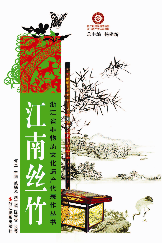江南丝竹
我国传统的民间器乐演奏形式,流行于上海、江苏南部、浙江西部一带。20世纪以来,曾出现过许多江南丝竹乐集社组织。江南丝竹乐队有“丝竹班”与“清客串”两种。“丝竹班”是专业性质的,为风俗节日或婚丧喜事演奏;“清客串”是自娱性质的,多在茶馆、私人住宅等地演奏。江南丝竹乐队编制最少2人(二胡、笛子), 一般3~5人,多亦可至7~8人。所用乐器有:二胡、小三弦、琵琶、扬琴、笛、箫、笙、鼓、板、木鱼、铃等。音乐风格轻巧、明朗、欢快、活泼,乐曲风格大都抒情优美,委婉细腻,善表现江南人民朴实健朗的欢乐性格和山清水秀的江南风貌。著名乐曲有《欢乐歌》、《云庆》、《行街》、《四合如意》、《三六》、《慢三六》、《中花六板》、《慢六板》八首,号称“八大名曲”。江南丝竹音乐曲式结构除一般民间音乐常见的单曲变奏与多首曲牌联缀曲式结构外,最大特点是以板式变化手法构成的曲式结构特点。如《老三六》可衍变为《中板三六》、《慢三六》,在节拍上是1/4、2/4、3/4的扩充变化。在演奏上,以二胡、笛子为骨干,其他乐器灵活自如地依据一定的规律相互对比、烘托,运用旋律上简繁相让,不同的音域以及不同乐器的演奏技法,使音乐在对比中展开。江南丝竹多用D宫体系内的羽、徵调式,在调式转换上,同宫体系内宫、羽调式交替较多,往往各小段音乐由强调宫或徵音开始而结束在羽音上,另外,上五度移宫形成调式性转换的情况最多。
江南丝竹
中国传统器乐丝竹乐的一种。流行于江苏南部和浙江一带。主要曲目有 “四合如意”、“欢乐歌”、“慢三六”、“云庆”、“行街”、“中花六板”、“三六”、“霓裳曲”八首,号称“八大名曲”。音乐结构主要有板式变化和曲牌联缀两种类型,以板式变化手法最有特点。它往往以一个曲牌为母曲,以放慢加花或加速减字的手法发展为几首独立乐曲。江南丝竹旋律抒情优美,风格清新流畅。笛子演奏注重气息的运用,高音悠扬清远,低音含蓄婉转,音色醇厚圆润,常用打音、倚音、赠音、震音、颤音等技巧润饰旋律。二胡方法饱满柔和,力度变化细腻,尤以各种滑音技法,构成江南丝竹细腻清秀、明快健朗的个性。
江南丝竹
江南丝竹流行于苏南、浙江及安徽一带,后来逐渐扩展到以上海为中心并广泛流行于以上区域的小城市,形成以城市为主、农村为辅的乐种。曲调细腻委婉,风格轻巧明朗、欢快活泼。乐曲概括地表现了江南人民朴实健朗的性格,体现出山青水秀的江南风貌。常用乐器有二胡、三弦、琵琶、笛、箫、笙、鼓板等,其中以二胡、笛子为主奏乐器,其他乐器起填补、衬托作用。

江南丝竹
江南丝竹有著名的八大名曲: “老三六”、“慢三六”、“中花六板”、“慢六板”、“欢 乐歌”、“云庆”、“四合如意”、“行街”。除了以上的八大名曲还有“霓裳曲”、“高山流水”、“鹧鸪飞”、“柳青娘”、“春江花月夜”等。在演奏中往往是由慢到快,各种乐器合奏时,在主旋律的基础上进行装饰加花,通常采用 “你简我繁”、“上动下静”、“有断有连”、“有高有低”的演奏方法。最初在民间婚丧喜庆以及庙会等活动中演奏,后来江南丝竹走向艺术化、搬上舞台。

主要责任者: 何平;陈睿睿
责任方式: 主编;执笔
出版者: 浙江摄影出版社
出版地: 杭州
页码: 1-185
开本: 32
中图分类号: J632.3
语种:中
定价:33.00
出版时间:2012-05
丛书多卷书否:是
丛书名:浙江省非物质文化遗产代表作丛书
丛书责任者:杨建新
丛书责任方式:主编
书目简介:本册工具书是浙江省非物质文化遗产代表作丛书之一,共收录15条词条。
被引频次:5